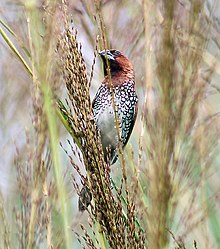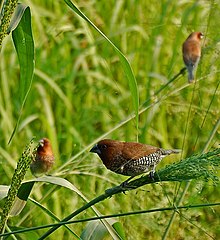Nutmegs
| Nutmegs | ||||||||||||
|---|---|---|---|---|---|---|---|---|---|---|---|---|

Nutmeg Amadine ( Lonchura punctulata ) |
||||||||||||
| Systematics | ||||||||||||
|
||||||||||||
| Scientific name | ||||||||||||
| Lonchura punctulata | ||||||||||||
| ( Linnaeus , 1758) |
The Scaly-Breasted Munia ( Lonchura punctulata ), also nutmeg Fink , nutmeg bird or nutmeg Munia called, is a kind from the family of finches , native to Southeast Asia.
The species plays a role in the keeping of ornamental birds and was naturalized as a captive refugee in various regions of the world.
Appearance
Adult birds
A total of 12 subspecies of the nutmegs have been described. Nutmegs show no sexual dimorphism .
The nominate form Lonchura punctulata punctulata is the 12 centimeter tall Indian muscat finch, which was described by Carl von Linné in 1758 . In this subspecies found in India and Sri Lanka , the head, throat, side of the neck and neck as well as the entire upper side of the body are uniformly chocolate to mahogany brown. On the underside of the body there is a clearly separated scale pattern, the basic color being white and the pattern being black-brown to black. The middle tail feathers and the upper tail-coverts are brown-yellow. The remaining tail feathers are dark brown with a brownish yellow border.
The middle of the abdomen as well as the rump and the under tail-coverts are completely white. The beak is black and the feet are blue-gray in color. The eyes are red-brown in color.
The other subspecies differ from the nominate form by a lighter brown, a scale pattern changed in color and shape, darker eye colors and differently colored upper tail-coverts.
Fledglings
The young birds are yellowish earth-brown on the upper side of the body. The tail and rump are also brown. The underside of the body is light yellow-brown and all dark drawings are still missing. The juvenile moult begins at the age of six to eight weeks and may last for up to five months.
The throat drawing of the boys is a slate black horseshoe, which is bordered by a wide yellowish white drawing in the same form on both sides. It is still visible in the adult birds.
voice
The nutmeg has a trilling that descends in stages, which also includes purring and whistling. The vocal repertoire is very different. It is not yet completely clear whether these singing differences are of an individual nature or whether the singing depends on the subspecies.
Distribution area and habitat
Nutmegs come from India and South China via Taiwan , Sri Lanka , Laos , Cambodia , Vietnam , Sumatra , to the Philippines , Bali , Lombok , Timor , Celebes and Java .
The nutmeg finch is one of the species that was introduced as a neozoon by humans in various regions of the world . The Chinese nutmeg finch ( L. p. Topela ) was naturalized in eastern Australia and has spread very widely there. It is now also found on the Seychelles , Mauritius and Réunion , on Cebu , the Caroline Islands , on Hawaii . Captive refugees are also found in Puerto Rico and southern Florida .
The habitat of the nutmegs are open areas. It occurs, for example, in wild grass and weeds. She has opened up the human settlement area as a habitat and likes to stay near rice fields, in gardens and on the edge of settlements. It is occasionally observed at higher altitudes and occurs in small numbers in the Himalayas and in the mountains of the Chinese border area at 2,000 meters. However, it usually resides at lower altitudes.
Way of life
Nutmegs are very sociable birds and mostly stay in small groups. However, larger swarms of more than a hundred individuals can form during rice ripening. Their food is mainly grass seeds that they ingest on the ground. Half-ripe grains of rice are also very popular with them, and in rice fields you can see them sitting close together on one or more stalks of nutmegs. The breeding season varies depending on the location. Nests are found in tropical lowlands at all times of the year, but the peak of reproductive activity usually falls during the monsoon rains. In the higher heights of the Himalayas, however, the breeding season is limited to the months of August and September. In Queensland , where the nutmeg finch was introduced, it breeds eleven months a year.
Nests are often created in colonies. Occasionally, nests are so close to each other that the nest walls touch. Thorn-reinforced trees are preferred as nesting sites. However, nutmegs also build their nests in the basal whorls of palm fronds. Nests can also be found in trellises or in creepers on verandas. When building a nest, between five hundred and seven hundred stalks are used. The clutch consists of four to seven white eggs. The incubation period is fifteen to sixteen days. Both parent birds participate in the breeding business. The young birds leave the nest for the first time after 21 to 25 days. However, they return to their brood nests to spend the night until they are independent.
attitude
Nutmegs were introduced to Europe at the beginning of the 18th century. Since then, they have been on sale regularly and frequently. The breeding rates are not very high, which is possibly due to the constant supply of imported birds. The Chinese subspecies Lonchura punctulata topela and the nominate form Lonchura punctulata punctulata, which is native to India, are most common in Europe .
The nutmeg finch is an ideal cage and aviary bird that is easy to get used to and that makes demands on housing and nutrition that make it possible for beginners to keep this species as well. With good husbandry, it can reach an age of seven to eight years. However, it only shows its highly developed social behavior when it is kept in a group in an aviary. Because of its peaceful nature, it is suitable for socialization with other fine finch species.
supporting documents
literature
- Horst Bielfeld : The finch book. All species, their keeping, care and breeding. Eugen Ulmer Verlag Stuttgart 1996, ISBN 3-8001-7327-1 .
- Jürgen Nicolai (Ed.), Joachim Steinbacher (Ed.), Renate van den Elzen, Gerhard Hofmann: Prachtfinken - Australia, Oceania, Southeast Asia. Eugen Ulmer Verlag, Stuttgart 2001, ISBN 3-8001-3249-4 .
- Peter Clement , Alan Harris, John Davis: Finches and Sparrows. An Identification Guide. Christopher Helm, London 1993, ISBN 0-7136-8017-2 .
Web links
- Lonchura punctulata in the endangered Red List species the IUCN 2008. Posted by: BirdLife International, 2008. Accessed January 31 of 2009.
- Videos, photos and sound recordings of Lonchura punctulata in the Internet Bird Collection




